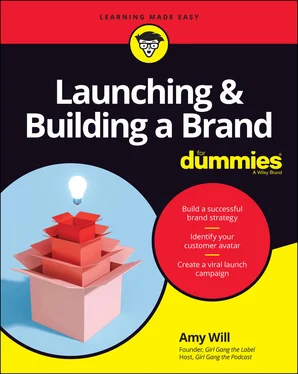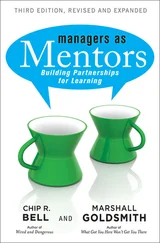Amy Will - Launching & Building a Brand For Dummies
Здесь есть возможность читать онлайн «Amy Will - Launching & Building a Brand For Dummies» — ознакомительный отрывок электронной книги совершенно бесплатно, а после прочтения отрывка купить полную версию. В некоторых случаях можно слушать аудио, скачать через торрент в формате fb2 и присутствует краткое содержание. Жанр: unrecognised, на английском языке. Описание произведения, (предисловие) а так же отзывы посетителей доступны на портале библиотеки ЛибКат.
- Название:Launching & Building a Brand For Dummies
- Автор:
- Жанр:
- Год:неизвестен
- ISBN:нет данных
- Рейтинг книги:5 / 5. Голосов: 1
-
Избранное:Добавить в избранное
- Отзывы:
-
Ваша оценка:
- 100
- 1
- 2
- 3
- 4
- 5
Launching & Building a Brand For Dummies: краткое содержание, описание и аннотация
Предлагаем к чтению аннотацию, описание, краткое содержание или предисловие (зависит от того, что написал сам автор книги «Launching & Building a Brand For Dummies»). Если вы не нашли необходимую информацию о книге — напишите в комментариях, мы постараемся отыскать её.
Launching & Building a Brand For Dummies,
Launching & Building a Brand For Dummies
Launching & Building a Brand For Dummies — читать онлайн ознакомительный отрывок
Ниже представлен текст книги, разбитый по страницам. Система сохранения места последней прочитанной страницы, позволяет с удобством читать онлайн бесплатно книгу «Launching & Building a Brand For Dummies», без необходимости каждый раз заново искать на чём Вы остановились. Поставьте закладку, и сможете в любой момент перейти на страницу, на которой закончили чтение.
Интервал:
Закладка:
Brand partnerships: A brand partnership is an agreement between at least two businesses that want to help each other increase their brand exposure. Teaming up with a brand that has an audience you’re hoping to reach can be very helpful. Strategically partnering with another brand can bring in a new audience, create sales opportunities, and offer brand exposure for both companies. (See Chapter 9for details about building strategic partnerships.)Impossible Foods, a vegan food company famous for its plant-based burger patty, teamed up with Burger King to create the Impossible Whopper. This brand partnership is a great match because each company is reaching a new market. Burger King is adding a menu item for vegetarian customers who previously wouldn’t buy its beef burgers, and Impossible Foods is reaching customers at a popular fast-food chain who may not have tried its product.
Traditional advertising: Depending on the product or service you offer, traditional advertising in the right outlet can help create brand awareness. If you’re launching a coaching business, taking out an advertisement in a magazine or journal that’s popular in your industry can give you exposure to precisely the market you’re trying to reach. Before buying any ad space, check out the publication’s circulation, which provides insight into the maximum number of people who will see the advertisement, as well as the demographic, which is the target audience. Use these to make sure the reach and target demographic align with your goals. For the purpose of increasing brand awareness, this metric (measure of value) is key.
THE POWER OF THE PRESS
To promote my husband’s Color Me Book brand (personalized coloring books), we created a press release and posted it to one media outlet: BuzzFeed Books. After the press release was picked up and trending on the main BuzzFeed website, we started attracting more interest for interviews and features.
To make it easy for others to discuss the launch of our company online (on their websites, blogs, and social media accounts), I posted our press release and media kit on our website in a section titled About Us. This material included the basic info, logos, and high-resolution photos needed to produce articles and other content about the Color Me Book brand quickly and easily.
I also included an email address dedicated to press inquiries that journalists and bloggers could use to contact us for interviews. As soon as news of his product hit the press, it went viral, and orders started pouring in.
Creating an emotional connection
In many ways, building a strong brand is about building strong relationships. People form relationships with one another based not so much on what they think about each other but on how they feel toward one another. The same is true of relationships that people create with their favorite brands. It’s not so much what they know about your brand but how they feel about it that keeps them coming back and endorsing it.
One of your top branding goals should be to create an emotional connection with existing and prospective customers and clients. Stop thinking so much about what your brand is and what it offers, and start thinking more about how prospective customers and clients feel about it. How does your brand affect their lives? Get personal. Taking a more personalized approach enables you to nurture an emotional connection between your customers and your brand.
Here are a few suggestions for getting your customers, clients, and prospects connected more emotionally to your brand:
Get connected to the people in your market. When you’re connected to others, you’re in tune with their needs and desires, what they like and dislike, and who they are. You “get” them, and when you do, you intuitively know what to do and say to get them to love your brand. Maybe they appreciate a good laugh. Maybe they’re afraid of what’s going on in the world. Maybe they have a common cause.When you know what makes your customers tick, you can market more effectively to them. If you’re serving a community that’s committed to environmental issues, you could post blog entries about environmental issues and perhaps offer products made from recycled materials.
Share real stories. People like to see brands in a real-life context, so look for opportunities to tell customer stories. Better yet, encourage customers to share their experiences with your brand. You can take advantage of this type of user-generated content (see Chapter 13) in your social media, website, and newsletter.
Add a personal touch. Nothing makes a person feel more emotionally connected to a brand than being acknowledged and appreciated personally. Adding a personal touch can be as simple as addressing customers by name, calling them on the phone when they have a complaint, or liking and sharing their social media posts about your brand. Strive to personalize your brand’s voice, as explained in Chapter 8, especially when you’re scaling up and having to delegate or outsource some or all of your marketing. Creating a brand style guide, as explained in Chapter 6, can help ensure consistency in your brand’s voice when you’re having to distribute your workload.
Differentiating your business, product, service, or self
Brand differentiation involves setting your brand apart from the competition, and it’s one of the most important branding goals. You want to plant the perception in the minds and hearts of existing and prospective customers and clients that your brand is different from and better than the alternatives. Otherwise, people have no reason to do business with you instead of one of your competitors.
To differentiate your brand, find or create a unique selling proposition and a value proposition. A unique selling proposition (USP) is a statement about what makes your brand different from and better than competing brands. A value proposition is a clear statement of the tangible benefits of your products and services.
Here are a few ways to differentiate your brand with USPs and added value:
Narrow your target demographic. New brands may not be able to win a war against bigger, well-entrenched brands, but they can win some battles to gain a foothold and start building momentum. Narrowing your target demographic enables you to differentiate your brand in a smaller market.
Create a different price point for a popular product. Notice that I said different, not lower. Your price may be lower to appeal to the budget-conscious or higher to appeal to the quality-conscious. Don’t start a price war with well-established brands. Why not? Well, for one thing, you’ll lose, and in the process, everyone in your industry will lose because you’re all trying to undercut one another.
Focus on customer service. Promising and delivering superior customer service is a great way to differentiate your brand when your brand is nearly identical to competing brands.
Differentiation is all about creating a market niche, as explained in Chapter 2.
Building credibility and trust
People buy only the brands they believe and trust, so one of your branding goals should be to build credibility and trust and not do anything that undermines these attributes. Here are a few ways you can build credibility and trust in your brand:
Demonstrate your knowledge and expertise. Use content marketing (valuable, relevant content that doesn’t explicitly promote your brand) to show that you know your stuff. You can distribute content in the form of web pages, blog posts, email messages, newsletters, press releases, podcasts, videos, and more.
Keep your promises. Salespeople have a motto: “Underpromise and overdeliver.” Don’t make your customers expect more than you can reasonably deliver. Do what you say you’re going to do. If you launch a preorder, be sure that the date you promise to ship the product is realistic; then meet or beat that date. If an unforeseen delay arises, keep your preorder customers informed so that they know what to expect.
Читать дальшеИнтервал:
Закладка:
Похожие книги на «Launching & Building a Brand For Dummies»
Представляем Вашему вниманию похожие книги на «Launching & Building a Brand For Dummies» списком для выбора. Мы отобрали схожую по названию и смыслу литературу в надежде предоставить читателям больше вариантов отыскать новые, интересные, ещё непрочитанные произведения.
Обсуждение, отзывы о книге «Launching & Building a Brand For Dummies» и просто собственные мнения читателей. Оставьте ваши комментарии, напишите, что Вы думаете о произведении, его смысле или главных героях. Укажите что конкретно понравилось, а что нет, и почему Вы так считаете.












